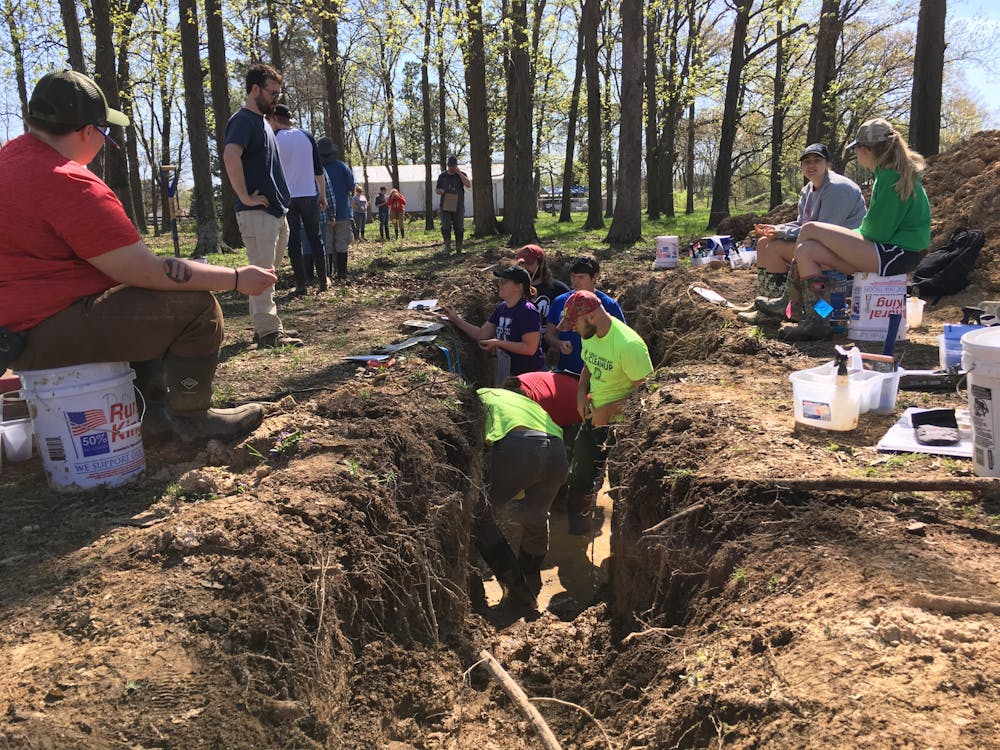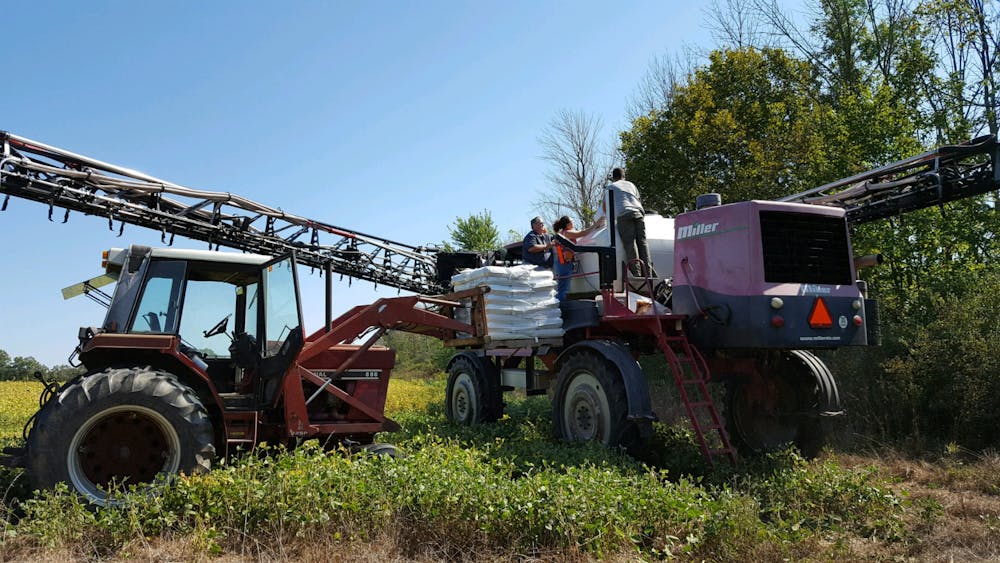Sand, clay, silt, peat, chalk and loam. All are different types of soil. According to ISRIC World Soil Information, soil filters rainwater to help prevent flooding, it helps plants grow and acts as a buffer against pollutants, which helps improve groundwater. Without soil, human life would be difficult.
The science of soil has always been a passion of Ball State University Assistant Professor of Natural Resources, Jessique Haeft, growing up in California. Since 2014, she has been sharing that passion with her students, teaching them valuable ways to care for the environment.
Eagerness for the Environment
Haeft grew up on a cattle ranch in California and attended California Polytechnic State University in San Luis Obispo.
While Haeft’s original interests lied with plants, her professors and other faculty gave her advice that not many plant scientists or horticulture majors truly understand the soil. In the end, she decided to major in soil science and take classes in horticulture — the best of both worlds.
Due to increasing tax rates, however, she soon began to witness the land in her surrounding area being sold off to developers.
“No one in my family could afford to keep it from generation to generation, and I really wanted to keep up with the farm lifestyle,” she said. “That is how I ended up in the Midwest, it is more affordable here to be able to do that.”
Haeft said there are a limited number of soil science programs around the nation, along with some people who specialize in what she does. So when her current position opened up at Ball State, Haeft made the move to Indiana.
“The position was like the perfect combination of everything I wanted to do,” she said. “There was the sustainable agriculture aspect, the soil aspect, and the classes they wanted me to teach were all areas of science that I had specialized in, so it worked.”
Now having been at Ball State for nearly nine years, Haeft continues to share her passion of soil sciences and sustainable agriculture with her students and colleagues.
“I just really fell in love with the part of soil where we describe all the different characteristics, basically the soil judging part, and not a lot of people specialize in that,” she said. “I kind of found a pathway to distinguish myself in my career and hopefully be successful, and I feel like I have that.”
Honoring the Earth
Every year, the biggest contribution Haeft said she makes to Earth Day is planting a tree with her kids on their property. In her classes, Haeft said she and her students always have a discussion about what they are doing for Earth Day and how it relates to what they have been learning.
She also protects the environment year-round by not using pesticides and growing her own food, so she limits the amount of fuel used to acquire such food and limiting her use of plastics. Haeft said she also does “a lot” of canning.
“I always try to teach my children and my students to try and educate as many people as possible about food insecurity around the world and how soil and water quality tie into that,” Haeft said. “The soil beneath our feet is an ecosystem, and it needs to be protected.”
Associate professor of natural resources and environmental management, Joshua Gruver, said another important thing to remember when it comes to our food is knowing where it comes from, understanding whether it is “in-season” or not, what the transportation was like getting it here and how much the transportation cost.
“When we get grapes, they are coming from Chile or somewhere else far away,” he said. “The dollar, or more, you pay for that gets spent and hardly any of it actually goes to the farmer who grew it, it goes to the transportation, so maybe you wait until grapes are in-season in the U.S. to shorten that chain.”
According to Gruver, the farmers who grow this produce, such as the grapes, only receive a profit of seven cents on the dollar.
The Soil Judging Team
Gruver said that Haeft has always been very passionate about her work, and her passion and excitement for her work really rubs off on her students. Current doctorate student Carson Wright has experienced that passion first-hand.
Wright met Haeft in 2015 and officially began working with her in 2016 when he took her soils class. Wright credits his decision to pursue a doctorate to Haeft, saying that when she asked him to come back and become one of her first doctorate students, the answer was clear.
“I have never heard someone talk about soil with that much excitement because that is just kind of a bland thing to most people,” he said. “Her excitement is just very contagious.”
Wright has had the opportunity to compete on the soil judging team, joining only the second round of students to ever be on it. Now being a graduate student, he has also had the opportunity to coach alongside Haeft.
“Learning about soil and peeling back those layers is so cool,” he said. “There is so much going on underneath our feet that none of us ever think about. That is why I got into soils because I like that mystery.”
Haeft said the soil judging team allows students to analyze soil for a variety of characteristics that they can later use to make decisions within their future careers.
A lot of times, however, students don’t find out about the soil judging team until they are juniors or seniors. Haeft wants the team to become more visible to freshmen and sophomores, so they can get involved and gain experience.
Wright said Haeft has always been great at teaching becayse she gets her students involved and gets them excited.
“I have often heard her say that one of the most rewarding things is getting to watch your students graduate and grow and to see them succeed and knowing you were a part of that process,” he said.

The Student Farm
After a big demand in students wanting a place where they can put into practice what they had been learning in class, Haeft began the process of obtaining a Discovery Grant in 2015 to gain funding to build Ball State’s student farm. Discovery is a women’s philanthropic leadership group established to support projects and programs at Ball State, according to Ball State’s Communication Center.
“It was a wild and fun experience,” Haeft said. “I wanted to create a place where students can get hands-on experience and really just dive in and try new things. That is why I created the student farm because it would be a space where students can make mistakes, and it would be okay.”
The farm is located in Albany, Indiana, at the Juanita Holts Environmental Learning Center. There, students grow 179 varieties of produce on the 99 acres of land the farm lies on, including herbs, lettuce, tomatoes, cucumbers, squash, sunflower and sweet corn.
The farm also recently received a United States Department of Agriculture (USDA) grant that they plan to use to move the high tunnel, a structure that extends the growing season, closer to campus for students who may struggle finding transportation to Albany. Haeft said this high tunnel would be close to Scheumann Stadium and will have access to the campus bus routes. She said it would also be used for growing larger plants such as corn and beans.
Haeft said she is currently studying different ways that students can try new things because it is harder for farmers to take the risks in the workforce.
Students at the farm learn and practice sustainable farming techniques. One technique Haeft and her students use is companion planting, which she said is combining different crops that compliment each other in some way.
“Often I have students who have never farmed or have very little experience in it,” Haeft said. “They learn by trial and error, and it sticks with them and makes them that much more successful.”
The most important lesson her students learn while working on the farm is how to work together, Haeft said, and how to supervise each other and how to guide teams.
“It is incredible watching my students grow because, a lot of times, I will get students who show up who are really quiet and don’t want to talk, but then, three weeks later, they are giving orders and coming up with plans,” she said. “It is just like watching plants flourish, I love seeing it.”
Haeft said one of her favorite memories of working with her students is that one morning at 5 a.m., her and her students were picking basil to go to the farmer’s market, and they were getting eaten alive by mosquitoes. She joked that she didn’t even know mosquitos were alive at 5 a.m.
“I remember looking out and seeing the tenacity of my students because they were so excited to be involved,” she said. “Not one of them complained, not one of them was mad about being here at 5 a.m. getting eaten by mosquitos. They could have very easily been miserable considering the circumstances, but they were laughing, joking around and playing music. It really showed me how Ball State’s students truly fly.”
Wright said that Haeft has always been great at reaching out to students to offer them opportunities they may not have even known about, which is something that not a lot of professors do.
“The student farm is an absolute blast to work on,” he said. “It is not your typical job where you are selling something to someone or stocking a shelf. You are outside and immersed in nature, and you are going to learn something new every day.”
Lessons Learned
A dream Haeft said she has for the farm is to create a giant pavilion or some kind of learning center where students can do demonstrations for the community, somewhere they can hold workshops or field days, rain or shine.
“My students are the future,” she said. “They are the ones that are going to be making the decisions that impact the coming generations, and I hope they feel passionate about their resources and protecting them.”
Haeft said she hopes to leave an impact on the environment by leaving an impact on her students. She wants them to be excited and have a love for soil and sustainable agriculture.
“The nature of education and research and trying new things is that you are going to fail 10,000 times before you get it right,” she said. “It is important to remember that you haven’t failed, you have just found 10,000 ways that didn’t work.”
Contact Savannah Jordan with comments at sjordan4@bsu.edu or on Twitter @savmjordann.





